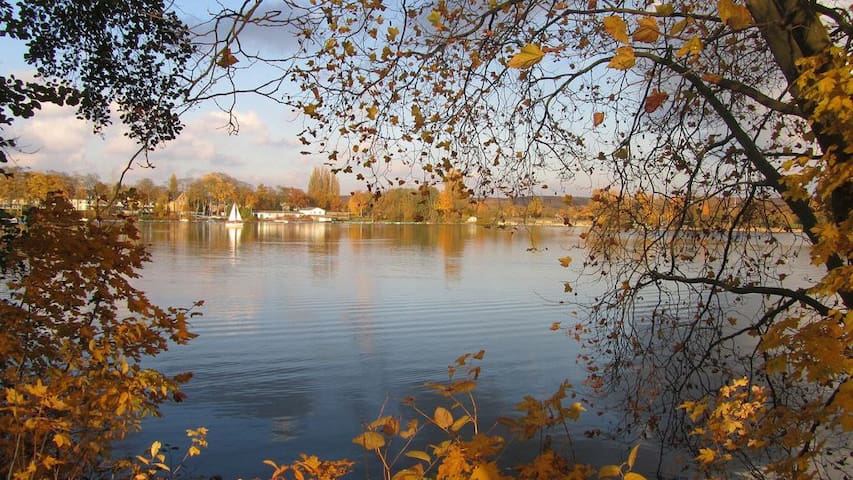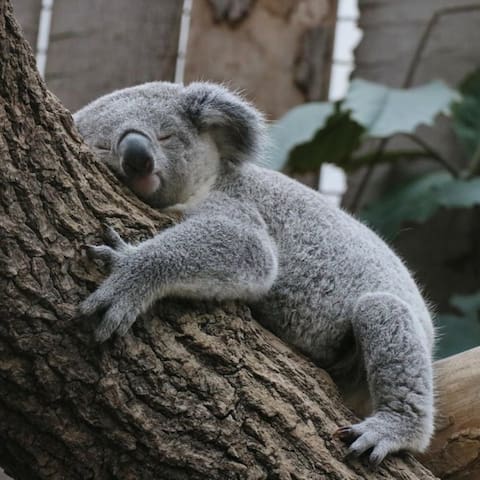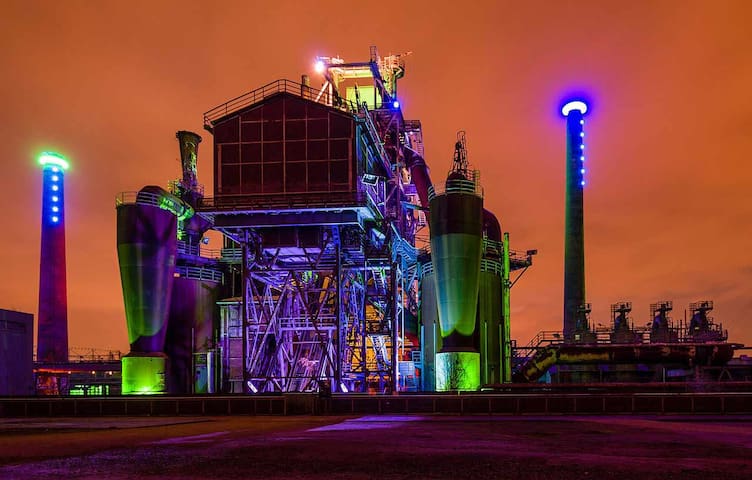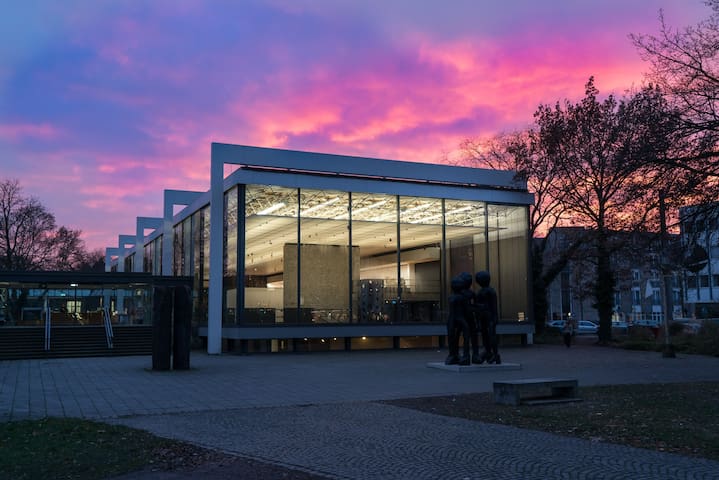Sehenswürdigkeiten
Duisburg’s industry will never feel further away than at this beauty spot and recreation area of six partly connected lakes.
And while you enjoy the 150-hectare site on a long walk, energising morning run or swim at the public bathing area it may be hard to believe that Sechs-Seen-Platte is all manmade.
These lakes were once a gravel pit dug by the Count Spee for his ancestral home Schloss Heltorf near Düsseldorf.
When the summer is in full swing people descend on the 25 kilometres of walking trails, golf course, horse-riding bridleways and 450-metre long beach, complemented by barbecue areas and restaurants.
26 personas locales recomiendan
Sechs-Seen-Platte
Duisburg’s industry will never feel further away than at this beauty spot and recreation area of six partly connected lakes.
And while you enjoy the 150-hectare site on a long walk, energising morning run or swim at the public bathing area it may be hard to believe that Sechs-Seen-Platte is all manmade.
These lakes were once a gravel pit dug by the Count Spee for his ancestral home Schloss Heltorf near Düsseldorf.
When the summer is in full swing people descend on the 25 kilometres of walking trails, golf course, horse-riding bridleways and 450-metre long beach, complemented by barbecue areas and restaurants.
Anyone with an affinity for industrial architecture will want to spend some time in Duisburg’s Inner Harbour, which was the lifeblood for the industrial city up to the 1960s.
From the Industrial Revolution in the 19th century the harbour was known as the “bread basket of the Ruhr”, storing grain in titanic granaries.
After the immediate post-war period the harbour went into decline and lay disused for decades before a regeneration scheme in the 90s.
Norman Foster drew up plans to turn Ruhr sites like this into districts for entertainment, offices and housing.
And today there are parks, museums, restaurants and companies on the water, many in converted brick industrial buildings.
20 personas locales recomiendan
Duisburg Inner Harbour
10 HansegrachtAnyone with an affinity for industrial architecture will want to spend some time in Duisburg’s Inner Harbour, which was the lifeblood for the industrial city up to the 1960s.
From the Industrial Revolution in the 19th century the harbour was known as the “bread basket of the Ruhr”, storing grain in titanic granaries.
After the immediate post-war period the harbour went into decline and lay disused for decades before a regeneration scheme in the 90s.
Norman Foster drew up plans to turn Ruhr sites like this into districts for entertainment, offices and housing.
And today there are parks, museums, restaurants and companies on the water, many in converted brick industrial buildings.
At the northern tip of the Duisburg Urban Forest, Duisburg Zoo is in 16 hectares and is a habitat for almost 300 animal species.
The attraction expanded in the post-war years around its water enclosures.
The biggest of these is the dolphinarium (also Germany’s largest), which has three million litres of seawater and is inhabited by nine bottle-nosed dolphins.
In the Rio Negro exhibit lives Baby, the last remaining Amazon dolphin in Europe.
As for terrestrial animals, the zoo is noted for breeding fossas, which are cougar-like mammals endemic to Madagascar.
Duisburg Zoo also breeds Koalas which are kept in their own “Koala House”, and you can get within centimetres of these marsupials behind glass panes.
44 personas locales recomiendan
Zoo Duisburg
273 Mülheimer Str.At the northern tip of the Duisburg Urban Forest, Duisburg Zoo is in 16 hectares and is a habitat for almost 300 animal species.
The attraction expanded in the post-war years around its water enclosures.
The biggest of these is the dolphinarium (also Germany’s largest), which has three million litres of seawater and is inhabited by nine bottle-nosed dolphins.
In the Rio Negro exhibit lives Baby, the last remaining Amazon dolphin in Europe.
As for terrestrial animals, the zoo is noted for breeding fossas, which are cougar-like mammals endemic to Madagascar.
Duisburg Zoo also breeds Koalas which are kept in their own “Koala House”, and you can get within centimetres of these marsupials behind glass panes.
In the Meiderich district in the north of the city is a disused steelworks that has been turned into a public park.
The facility shut down in 1985, and so in the early 90s, instead of demolishing the blast furnaces, conveyor bridges and chimney stacks the landscape architect Peter Latz decided to keep them.
The ground was cultivated with plants to remove pollution from the soil, and where possible the infrastructure has been repurposed: The old sewage canals and railways are walking paths, a gasometer has become a scuba diving centre, while concrete bunkers have become gardens, walls now accommodate climbers and a blast furnace is a viewing tower.
The Landschaftspark is on the Ruhr’s Industrial Heritage Trail and often ranks among the top city parks in the world.
74 personas locales recomiendan
Parque del Paisaje
71 EmscherstraßeIn the Meiderich district in the north of the city is a disused steelworks that has been turned into a public park.
The facility shut down in 1985, and so in the early 90s, instead of demolishing the blast furnaces, conveyor bridges and chimney stacks the landscape architect Peter Latz decided to keep them.
The ground was cultivated with plants to remove pollution from the soil, and where possible the infrastructure has been repurposed: The old sewage canals and railways are walking paths, a gasometer has become a scuba diving centre, while concrete bunkers have become gardens, walls now accommodate climbers and a blast furnace is a viewing tower.
The Landschaftspark is on the Ruhr’s Industrial Heritage Trail and often ranks among the top city parks in the world.
In the folds of the Immanuel Kant Park the Lehmbruck Museum is devoted mostly to sculpture, and tracks the career of the Duisburg-based artist Wilhelm Lehmbruck.
The museum has 100 or so of his works, as well as his sketches, drawings and paintings in a separate building.
But Lehmbruck only makes up a fraction of a collection so large it needs to be reinstalled every year.
You can view sculptures by Alberto Giacometti, Joseph Beuys, Picasso, Käthe Kollwitz, Alexander Archipenko and Christo, to name a small few.
There’s also 19th and 20th-century painting, mainly Expressionism from Die Brücke artists like Emil Nolder, Max Pechstein, Kirchner, August Macke, as well as art from the Bauhaus school by Ernst Eilhelm Nay and Max Beckmann.
In Immanuel Kant Park you can tour the sculpture garden, furnished with 40 works, by Lehmbruck, Henry Moore and Méret Oppenheim.
13 personas locales recomiendan
Lehmbruck Museum
40 Düsseldorfer Str.In the folds of the Immanuel Kant Park the Lehmbruck Museum is devoted mostly to sculpture, and tracks the career of the Duisburg-based artist Wilhelm Lehmbruck.
The museum has 100 or so of his works, as well as his sketches, drawings and paintings in a separate building.
But Lehmbruck only makes up a fraction of a collection so large it needs to be reinstalled every year.
You can view sculptures by Alberto Giacometti, Joseph Beuys, Picasso, Käthe Kollwitz, Alexander Archipenko and Christo, to name a small few.
There’s also 19th and 20th-century painting, mainly Expressionism from Die Brücke artists like Emil Nolder, Max Pechstein, Kirchner, August Macke, as well as art from the Bauhaus school by Ernst Eilhelm Nay and Max Beckmann.
In Immanuel Kant Park you can tour the sculpture garden, furnished with 40 works, by Lehmbruck, Henry Moore and Méret Oppenheim.




